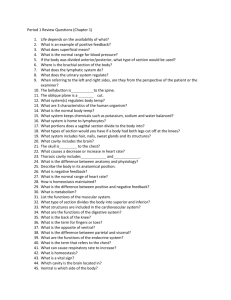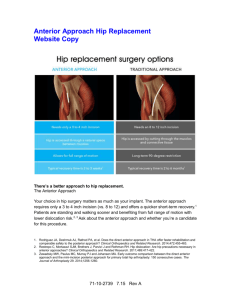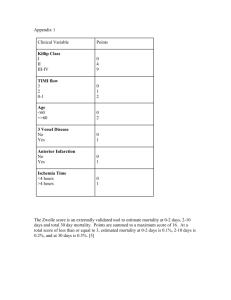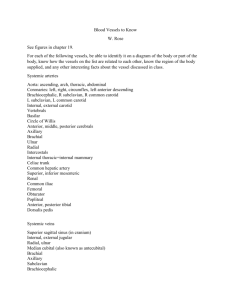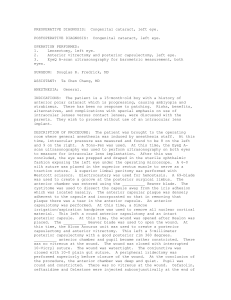Australopithecine anterior pillars
advertisement
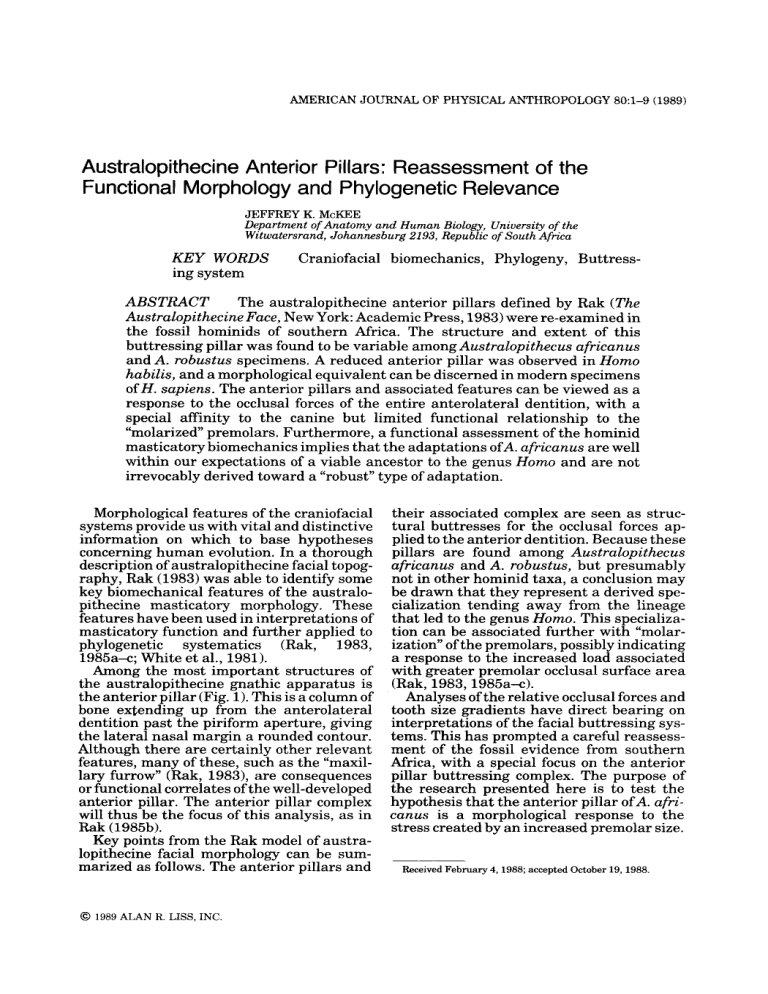
AMERICAN JOURNAL OF PHYSICAL ANTHROPOLOGY 801-9 (1989) Australopithecine Anterior Pillars: Reassessment of the Functional Morphology and Phylogenetic Relevance JEFFREY K. McKEE Department of Anatomy and Human Biology, University of the Witwatersrand, Johannesburg 2193, Republic of South Africa KEY WORDS Craniofacial biomechanics, Phylogeny, Buttress- ing system ABSTRACT The australopithecine anterior pillars defined by Rak (The Australopithecine Face, New York: Academic Press, 1983)were re-examined in the fossil hominids of southern Africa. The structure and extent of this buttressing pillar was found to be variable among Australopithecus africanus and A. robustus specimens. A reduced anterior pillar was observed in Homo habilis, and a morphological equivalent can be discerned in modern specimens of H. sapiens. The anterior pillars and associated features can be viewed as a response to the occlusal forces of the entire anterolateral dentition, with a special affinity to the canine but limited functional relationship to the “molarized premolars. Furthermore, a functional assessment of the hominid masticatory biomechanics implies that the adaptations ofA. africanus are well within our expectations of a viable ancestor to the genus Homo and are not irrevocably derived toward a “robust”type of adaptation. Morphological features of the craniofacial systems provide us with vital and distinctive information on which to base hypotheses concerning human evolution. In a thorough description of australopithecine facial topography, Rak (1983) was able to identify some key biomechanical features of the australopithecine masticatory morphology. These features have been used in interpretations of masticatory function and further applied to phylogenetic systematics (Rak, 1983, 1985a-c; White et al., 1981). Among the most important structures of the australopithecine gnathic apparatus is the anterior pillar (Fig. 1).This is a column of bone extending up from the anterolateral dentition past the piriform aperture, giving the lateral nasal margin a rounded contour. Although there are certainly other relevant features, many of these, such as the “maxillary furrow’’ (Rak, 1983), are consequences or functional correlates of the well-developed anterior pillar. The anterior pillar complex will thus be the focus of this analysis, as in Rak (1985b). Key points from the Rak model of australopithecine facial morphology can be summarized as follows. The anterior pillars and @ 1989 ALAN R. LISS, INC their associated complex are seen as structural buttresses for the occlusal forces applied to the anterior dentition. Because these pillars are found among Australopithecus africanus and A. robustus, but presumably not in other hominid taxa, a conclusion may be drawn that they represent a derived specialization tending away from the lineage that led to the genus Homo. This specialization can be associated further with “molarization” of the premolars, possibly indicating a response to the increased load associated with greater premolar occlusal surface area (Rak, 1983,1985a-c). Analyses of the relative occlusal forces and tooth size gradients have direct bearing on interpretations of the facial buttressing systems. This has prompted a careful reassessment of the fossil evidence from southern Africa, with a special focus on the anterior pillar buttressing complex. The purpose of the research presented here is to test the hypothesis that the anterior pillar ofA. africanus is a morphological response to the stress created by an increased premolar size. Received February 4,1988; accepted October 19,1988. 2 J.K. McKEE cast of AL-200-1, a partial maxilla from Hadar (Kimbel et al., 1982) that is commonly assigned to the putative taxon “Australopithecus afarensis” (Johanson et al., 1978). Crania of modern Homo sapiens from the Raymond A. Dart Collection of Human Skeletons were employed for comparative purposes. Notes were made of the relative extent and position of maxillary buttressing features. Buttressing columns or ridges were located at the inferior margin of the maxillary alveolar processes, where they constitute the juga over the tooth roots, and followed superiorly. In this way various morphological configurations could be identified in order to assess the biomechanical relevance of the supporting framework. THE FOSSIL EVIDENCE Fig. 1. Austrulopithecus ufricunus from Sterkfontein (STS-51, exhibiting the classic, well-developed anterior pillar. Alternative hypotheses involving functional and behavioral adaptations are also considered in light of the fossil evidence, with a further exploration of the phylogenetic implications. MATERIALS AND METHODS PlioceneK’leistocene fossils of southern Mrica, housed at the Transvaal Museum, Pretoria, and at the University of the Witwatersrand, Johannesburg, comprised the majority of the sample assessed. This included 11 specimens of A. africanus fossils from the sites of Sterkfontein and Makapansgat (STS-5, STS-17, STS-52a, STS-53, STS-63, STS-71, TM-1512, TM-1511, STW13, MLD-6, and MLD-9). Nine A. robustus fossils were assessed from the sites of Swartkrans and Kromdraai (SK-11, SK-12, SK-13, SK-46, SK-48, SK-52a, SK-79, SK-83, and TM-1517). These specific classifications are based on palaeoanthropological dogma and correspond to those used by Rak (1983) for ease of comparison. An additional assessment was made of early hominid fossils assigned to the genus Homo (STW-53 and SK-8471, as well as a Superficial examination of these fossils reveals that an association of the anterior pillars with a need for the buttressing of molarized premolars is a distraction from one remarkably obvious feature: the anterior pillar is consistently centered on the canine tooth. The base of the anterior pillar usually flares out to include the I2 medially and the mesial root of the P3laterally. This is clearly the case in A. africanus specimens STS-5, STS-52a, MLD-6, and MLD-9, as well as A. robustus specimens SK-12, SK-13, SK-46, SK-83, and TM-1517. In a few other fossils, the I2is not obviously implicated, leaving the anterior pillar to be associated directly with just the canine and P3 mesial root. These include STS-17, STS-53, STS-71, and TM1511 ofA. africanus and SK-11, SK-48, SK52, and SK-79 ofA. robustus. Gnathic morphology among australopithecines is better revealed by the deviations from these standard patterns, as seen in a more detailed examination. In a “robust” specimen, SK-13, the mesial roots of the P3 appear to bypass the lateral aspect of the anterior pillar. On the left, the P3 roots are visible because of breakage of the alveolar bone, revealing fused mesial and distal roots directed posterolaterally away from the anterior pillar, toward the zygomatic root. A functional relationship of the anterior pillar to the canine is further elucidated by the A. africanus specimen TM-1512 (Fig. 2A). In this individual, the anterior pillar, albeit in a reduced form (Rak, 19831,is solely an extended buttress for the canine tooth. There is a smaller ridge running lateral to AUSTRALOPITHECINE ANTERIOR PILLARS 3 Fig. 2. Small buttressing ridges associated with the anterior pillars. A A. ufricunus specimen TM-1512. Arrowheads indicate a lateral ridge that is separate from the anterior pillar proper (partially accentuated by a vertical crack in the fossil). B: Lateral ridge indicated by arrowheads is inferiorly subsumed by the well-developed anterior pillar in this A. robustus individual (SK-12). 4 J.K. M c m E the anterior pillar proper, directly above the mesial portion of the P3. This ridge, however, runs away from the nasal margin toward the infraorbital foramen, yet lies medial to the “maxillary furrow.” The morphology of TM-1512 is suggestive that the cause, or at least the functional demand, for the anterior pillar may not be occlusal forces applied t o a molarized P3. A close look at SK-12 (Fig. 2B) lends further support to this idea. This specimen reveals that the canine root extends through most of the anterior pillar, almost to the level of the floor of the nasal cavity. The P3 has a root going clearly into the lateral part of the base of the anterior pillar. However, at the level of the floor of the nasal cavity, the pillar appears to bifurcate; the main portion, or anterior pillar proper, continues anteromedially along the nasal margin, as a small lateral ridge diverges toward the root of the zygomatic process of the maxilla. This lateral offshoot is in approximately the same relative position as the lateral ridge seen over the mesial root of the P3in TM-1512. In other words, the inferior portion of the lateral ridge has been subsumed by the anterior pillar in SK-12. In the specimens TM-1512, STS-52a, and possibly STS-53, all of which are A. africanus, the anterior pillars are less well developed. This emphasizes the variability in anterior pillar size and morphology. Rak (1983, 1985a) noted this variability, but attributed the reduction in development to sexual dimorphism. This may or may not be a fair assessment, but these australopithecine specimens do reflect a variability that may set the stage for the Sterkfontein fossil STW-53, which Hughes and Tobias (1977) assign to the taxon H. habilis. This particular specimen also seems to have reduced anterior pillars extending well beyond the root of the canine alongside the inferolateral nasal margin; it clearly has more of a remnant of the anterior pillar than SK-847, which is believed to be a Homo erectus (Clarke, 1985). Tobias (1988) has made a similar observation on the OH-24 specimen of H. habilis from Olduvai Gorge and observed only a lesser degree of development as opposed to the total lack of an anterior pillar in OH-24 claimed by Rak (1983). Some early hominid fossils do indeed reveal that Rak’s “anterior pillar” appears to have buttressed part of the occlusal forces applied to the P3. However, the salient fea- ture of this buttressing system is that it is centered squarely over the canine and in a few cases also includes the lateral incisor. The combined projection of these roots into one trajectory is also observable in H. sapiens. Fifty modern human skulls were taken as a random sample from the Raymond A. Dart Collection of Human Skeletons. In three individuals (6%),as illustrated by the maxilla in Figure 3, a development closely resembling the anterior pillar was clearly evident (McKee, 1988a). The bony buttress extends well beyond the tip of the canine and mesial P3 roots, traversing near the inferolateral border of the nasal margin. While the overall facial architecture is quite different from that of A. africanus, this feature parallels some of the gracile australopithecine fossils, such as TM-1512 (Fig. 2A). DISCUSSION Analysis of fossil hominid and modern human crania elucidates the variability in development of tooth root juga and the anterior pillars. One can redefine the anterior pillar according to this variability as the combined tooth root juga of the canine and adjacent teeth, which extends superiorly beyond the root tips of these teeth. Such a definition will accommodate the variability seen among A. africanus fossils, but then must also encompass anterior maxillary buttresses found among Homo, including H. sapiens. Furthermore, if one considers this variation in degree of anterior pillar development, rather than applying strict criteria for presence or ab- Fig. 3. A fully modern human skull with a reduced “anteriorpillar.”The buttressing complex is developed beyond that seen in TM-1512 (Fig. 2A), but less than that of STS-5 (Fig. 1) or SK-12 (Fig. 2B). AUSTRALOPITHECINE ANTERIOR PILLARS sence of the feature, it is then necessary to reassess the biomechanical implications as well as the phylogenetic relevance. Hominid masticatory biomechanics Limitations are intrinsic to any assessment of masticatory biomechanics because of anatomical entanglements with competing systems of the head and neck. The bony framework for the masticatory apparatus must be integrated with the visceral structures for communication, respiration, deglutition, and vision. During the course of hominid evolution, the attainment of orthograde posture and the expansion of the brain placed further constraints on the evolving masticatory apparatus (Weidenreich, 1943; DuBrul, 1977,1980). Even if one could hold these other systems constant, there is a suite of features that can affect variations in occlusal loading patterns. At once we must be cognizant of the mechanics of the muscles of mastication as well as of the requirements for a sound supporting framework. With these qualifications in mind, I shall focus here on only a few relevant features and will leave the proposed model open to refinement. Enlargement of the temporal fossa is possibly the most striking feature that distinguishes the cranium of the “robust”and “hyper-robust” australopithecines from the “gracile”forms. There is a greater flaring of the zygomatic arches and, relative to the face, a narrower postorbital constriction ofA. robustuslboisei, resulting in remarkably large temporal foramina, necessary for accommodatingpowerful masticatory muscles. The origins and insertions of both the temporalis and masseter muscles, as indicated by reconstructions of fossil crania, show distinct trends toward long moment arms of both muscles, implying a strong and posteriorly located maximum bite force (DuBrul, 1977; Rak, 1983; McKee, 1985). Kimbel et al. (1984) noted the strong, apelike facial prognathism of A. africanus and “A. ufurensis.” An increase in prognathism doubtlessly tends to weaken the overall mechanical advantage of the masseter and temporalis muscles (Throckmorton et al., 1980; Ward and Molnar, 1980). The mechanical simulations of Ward and Molnar (1980) suggest that the gradient of occlusal forces increased toward the posterior teeth if the dentition was moved forward from the mandibular condyle. On the other hand, studies 5 of mammals (DuBrul, 1977) and living humans (McKee, 1985, 1988b) show that the relative occlusal forces applied to the anterior dentition may increase with greater prognathism. This apparent contradiction vividly illuminates the difficulties in assessing the effects of an alteration in one aspect of a suite of functionally related features in the masticatory apparatus. Knowledge of temporalis muscle action is essential for the understanding of masticatory variability among early hominids, crania of which exhibit varying degrees of prognathism both within and between species (Bilsborough and Wood, 1988). Analyses have shown that it is the middle and posterior fibers of the temporalis muscle that will have a greater effect on the forces applied to the anterior dentition (Endo, 1970; Hylander, 1983; Ward, 1974). Thus the forward positioning of the temporalis muscle among the more orthognathic robust australopithecines (Rak, 1983)could not occur to the same degree in some of the more prognathic A. africunus specimens, for it would then lose its biomechanical advantage for anterior occlusal forces. Such a conclusion is supported by the hyper-robust KNM-WT 17000 (Walker et al., 1986; Leakey and Walker, 1988), which differs from the other “robust” fossils in its greater prognathism and apparently well-developed temporalis muscle, including an extraordinarily large area of origin for the posterior fibers. Rak (1983) sees anterior encroachment of the temporalis as being associated with greater anterior occlusal forces, but this can be true only if the palate is retracted (with respect to the masticatory musculature). Such is the case among most A. robustuslboisei fossils, resulting in greater forces over the entire dentition. Evolutionary differences among australopithecines in the size of the temporal fossae and the degree of alveolar prognathism are functionally significant. Application of the biomechanical analyses to the fossils implies that some A. africanus individuals would have had relatively greater anterior occlusal forces, whereas the robust forms, with a retracted palate in relation to increased masticatory musculature, should have had stronger and more posteriorly applied masticatory force. The dentitions of the two types generally reflect this, with A. africunus having relatively larger anterior dentition, while the A. robustus dentition is focused on 6 J.K. McKEE enlarged postcanine teeth (Robinson, 1956)) reaching an extreme in the East African A. boisei (Tobias, 1967). The interspecific variation in the masticatory apparatus suggests at least three explanatory models. While these are not mutually exclusive, they are treated separately below. Molarization of thepremolars. Relative to the maxillary premolars of the Hadar and Laetoli Australopithecus material, southern African A. africanus premolars may well be slightly molarized in size and morphology, but not beyond the range of later Homo. The P3 is totally within the size range of Homo spp., as published by White et al. (1981).The present study has shown that it is only the mesial root of the P3that is sometimes functionally associated with the australopithecine anterior pillar, thus severely limiting the role of the premolars in anterior pillar formation. One cannot rule out the possibility that in some specimens the anterior pillar has simply overgrown and subsumed the P3 mesial root as a response to the forces applied to the canine. Salient features of the A. africanus dentition include large incisors and a n especially large canine (Robinson, 1956). Arter (1986) has suggested that the large anterior teeth would require adequate buttressing and may account for the A. africanus facial morphology. However, there must be more to the buttressing system than tooth size, for the Hadar Australopithecus fossils also demonstrate large anterior teeth but have no apparent anterior pillar. This suggests that other morphological and behavioral adaptations may have contributed to the variations in facial development, as discussed below. Dietary hypothesis. Potential behavioral explanations for differences in gnathic morphology often focus on Robinson’s “dietary hypothesis” (1954,1963). Dietary preference may indeed be a reasonable explanation for the greater occlusal surface area of the postcanine teeth in some robust and hyperrobust australopithecines, as opposed to other hominids with a less herbivorous diet. However, a slight “molarization” of the premolar in A. africanus, as compared with “A. afarensis,” does not seem sufficient to suggest an adaptational shift in diet toward that implied by the llrobust))masticatory configurations. On the contrary, it is the anterior dentition ofA. africanus that is quite distinct from that of A. robwtus and A. boisei. Omnivory among A. africanus is certainly compatible with their pattern of hetero- donty. One should hesitate, however, to attribute the greater size of the A. africanus anterior dentition to diet alone, for the incisors and canine must have had multiple functional roles. Thus we must look at functions of the dentition that are complementary to the dietary role. Oral prehension. The anterior teeth of A. africanus must have sustained considerable loads, as suggested by three lines of evidence. First, large anterior teeth would probably not have evolved o r been maintained without some selectively advantageous function. Second, the anterior teeth were heavily utilized, as implied by their considerable wear (Robinson, 1956). Third, the prognathism and associated craniofacial features may imply relatively greater anterior occlusal forces. Regardless of the biomechanical properties of jaw movement and occlusal forces, the prognathism would have required sufficient buttressing, as suggested by Rak (1983). Additional functions of this suite of features may relate to the use of the teeth as tools, beyond that directly related to diet. Although Wallace (1972) sees the anterior tooth rounding as a result of dietary abrasion, this should not eliminate compound attrition caused by additional uses of the teeth. There is more than one way to use the anterior dentition. Later hominids did indeed use their larger incisors as tools. This apparently did not require great strength in the jaws, for the masticatory musculature was weakened and the buttressing systems diminished through evolutionary time. An explanatory model must then take into consideration an oral function that requires powerful musculature and firm canine buttressing, as well as large incisors. Notably profound loading of the anterior dentition, suggested by the presence of a well-developed buttressing system, could be caused by the use of the teeth for prehension. If the A. africanus individuals were using the anterior dentition as a vise grip, or even carrying things in their mouths, then they would have required the features we see as functional adaptations. Large incisors and canines for gripping would have necessitated firm buttresses in a prognathic face. Welldeveloped masticatory muscles with long moment arms would have provided considerable strength, with the important component of mandibular retraction coming from the posterior fibers of the temporalis muscle. Despite the tempting inference of oral pre- AUSTRALOPITHECINE ANTERIOR PILLARS hension, the argument is tautologous: one cannot infer that prehension creates a facial configuration based solely on the presence of certain facial features. Thus the hypothesis must be tested by independent evidence, of which comparative studies of anterior dental attrition patterns may be the most useful. The rounded wear of the incisors and heavy wear of the canines provide vital clues, which seem to be consistent with the model. There are at least two intriguing issues remaining if one holds to the above arguments. The first problem is to determine why the earlier Australopithecus fossils from Hadar, with large anterior teeth and considerable prognathism, do not exhibit anterior pillars. It is difficult to assess possible variability in the adult structure of these individuals because of the fragmentary and distorted nature of the fossils (Rak, 1983). Again we must look beyond the collection of morphological traits and approach an assessment of tooth usage. If it is true that the wear of the dentition was greater on the molars than on the anterior dentition (White et al., 1981; Kimbel et al., 19841, then we have evidence for behavioral differences that may indeed account for the differences in adaptations of the facial morphology. There is, however, a problem in that the reconstructed cranium of “A. afarensis” suggests very well-developed posterior (horizontal) fibers of the temporalis in association with a poorly buttressed anterior face and a posterior dental wear gradient (White et al.,1981; Kimbel et al., 1984); such a biomechanically incongruous configuration may be a consequence of a reconstruction based on 12 different individuals. A second issue relates to the A. robustus specimens: Why do they have anterior pillars? An initial explanation, as Rak (1983, 1985b) has suggested, is that there were considerable functional demands for a buttressing system because of the well developed masticatory musculature. Although the temporalis muscle has been moved forward, the entire dentition has been retracted below the lengthened moment arms of the masticatory muscles, resulting in considerable forces over the entire dentition. It is difficult to attribute this solely to molarization of the premolars, for it is only the mesial half of the P3 that manifestly contributes to the anterior pillar; furthermore, SK-12 demonstrates that the P3 may have its own buttressing trajectory that has simply been subsumed by the well-developed anterior pil- 7 lar. Thus a retraction of the palate seems to be a key feature requiring the evolutionary retention of the anterior pillar, although it is functionally very different from that of A. africanus. Phylogenetic considerations Underlying most phylogenetic schemes for hominid evolution is a close relationship of A. africanus to A. robustus. Thus it is not unlikely that the robust forms inherited the anterior pillar from A. africanus or from the immediate common ancestor of both species. This does not imply that A. africanus was specialized in the direction of A. robustus, but rather that A. robustus retained some primitive features from its ancestor. Indeed, H. habilis also has retained the anterior pillar, but in a reduced form. Natural selection would not operate to maintain an anterior pillar in the evolving hominids, for as the masticatory musculature is weakened, in association with a reduced canine and perhaps decreased demand on the anterior teeth for prehension, the large buttress would no longer be required. We should thus see the reduced form of the pillar found in some A. africanus specimens and in H . habilis. Structures resembling reduced anterior pillars remain in a small percentage of modern H. sapiens, suggesting consistency of gnathic morphology that just varies in degree of development. Gradual reduction of the anterior pillar complex is seen by Rak (1983, 1985b) as a suspect evolutionary reversal. Such an idea is based on the assumption that the primitive form did not have an anterior pillar. He finds evidence for this in the earlier Hadar Australopithecus, which apparently does not have an anterior pillar, but he goes further by stating that the great apes reflect the primitive form, showing a “generalized facial morphology without anterior pillars. One may argue that it is no more legitimate to use extant great apes as a model for the primitive form of craniofacial structures than to use them as models for the primitive form of locomotion. Surely the chimpanzee and gorilla forms have evolved into their own unique craniofacial configurations that accommodatethe anterior occlusal forces without a need for anterior pillars. Likewise, while the existing “A.afarensis” specimens show some “primitive” features, these must be considered within the context of the entire masticatory system and behavioral milieu. 8 J.K. McKEE If the reduction of the anterior pillars does represent an evolutionary reversal, then we should not be too concerned, for such reversals are quite common in hominid evolution. Reversals from loss of a structure to reattainment are usually suspect; reversal from development of a structure to later reduction of it is an expected norm. For example, the thick cranial vault of H . erectus is found in neither its predecessors nor its successors. Likewise, dentition is notorious for reversals, as one sees anterior tooth size of the genus Homo reaching its evolutionary peak among the Neandertals and then declining (Brace, 1967). The Rak evolutionary model also implies a kind of a reversal, for A. boisei allegedlylost the anterior pillars of its predecessor by retracting the masticatory apparatus. In terms of both function and phylogeny, this argument logically parallels one in which H . habilis and H . erectus lost a buttressing structure by a weakening and slight reconfiguration of the jaws. Selective forces operating among the Neandertals and their contemporaries provide a further interesting parallel. This group had presumably evolved large anterior teeth to use as tools, but experienced a reduction following the development of other tools that fulfilled the previous functional role of the teeth. A similar model fits much earlier in hominid evolution. Perhaps the weakened masticatory apparatus, reduced canines, and reduced anterior pillars of H. habilis occurred when something, such as rudimentary stone tools, supplanted the functional role of these structures. Hypotheses concerning phylogenetic relationships must encompass the total morphological pattern (Tobias, 19851, with special reference to functional morphology, for the masticatory system does not evolve or operate in isolation from other craniofacial systems, and the anterior pillars do not exist as anything more than a small part of the entire system of masticatory biomechanics. Likewise, morphological traits do not evolve independently of behavioral adaptations. Thus one cannot build a phylogeny on the basis of one feature, or even of one functionally correlated suite of features, as done by Rak (1985b). On the contrary, it is clear that a species cannot be eliminated from a lineage on such grounds and, in particular, that there is no legitimate reason to exclude A. ufricunus from the hominid lineage that leads to the genus Homo. SUMMARY AND CONCLUSIONS Ostensibly, the anterior pillars are a part of a facial buttressing system for support of the anterior dentition. Among the australopithecinae, these pillars are primarily extensions of the canine juga, but can also serve as buttresses for the lateral incisors and mesial roots of the first premolars. Other buttressing systems, such as the maxillary zygomatic process, support the remaining premolar roots. Thus we must reject the hypothesis that the anterior pillars were derived to accommodate molarized premolars. An alternative hypothesis to explain variability in anterior pillar development among early hominids may be found in an analysis of behavioral adaptations, such as oral prehension, along with a functional assessment of the suite of integrated features in the craniofacial skeleton. There is considerable variability in the degree of development of the anterior pillars found among A. africanus and A. robustus. H . habilis has a distinct but reduced form of this buttressing structure, while even some H. sapiens exhibit comparable morphology. These similarities allow consideration of a phylogenetic sequence in which the A. africanus anterior pillars are reduced gradually throughout the evolution of Homo. ACKNOWLEDGMENTS I am very grateful for the insightful guidance of Professor Phillip V. Tobias and for access to the fossils under his care. I thank Dr. C.K. Brain, who very kindly offered me access to the fossils at the Transvaal Museum, and David Panagos for his help with the collection. Dr. Michel Toussaint and Dr. Gabriel Macho provided very useful suggestions and moral support. Three anonymous referees aided in the tightening of my manuscript. LITERATURE CITED Arter DD (1986) Evolution of the australopithecine face [Abstract]. Am. J. Phys. Anthropol. 69(2):172. Bilsborough A, and Wood BA (1988) Cranial morphometry of early hominids: Facial region. Am. J. Phys. Anthropol. 76(1):61-86. Brace CL (1967)Environment, tooth form, and size in the Pleistocene. J. Dent. Res. 46(5):809-816. Clarke FLJ (1985) Austrulopithecus and early Homo in southern Africa. In E Delson (ed.): Ancestors: The Hard Evidence. New York: Alan R. Liss, pp. 171-177. DuBrul EL (1977) Early hominid feeding mechanisms. Am. J. Phys. Anthropol. 47:305-320. DuBrul EL (1980) Sicher’s Oral Anatomy, 7h ed. St. Louis: The C.V. Mosby Company. AUSTRALOPITHECINE ANTERIOR PILLARS Endo B (1970) Analysis of stresses around the orbit due to masseter and temporalis muscles respectively. J. Anthropol. SOC.Nippon 78(4):251-266. Hughes AR, and Tobias PV (1977)A fossil skull probably of the genus Homo from Sterkfontein, Transvaal. Nature 265(55921:310-312. Hylander WL (1983) Posterior temporalis function in macaques and humans [Abstract]. Am. J . Phys. Anthropol. 60(2):208. Johanson DC, White T, and Coppens Y (1978) A new species of the genus Austrulopithecus (Primates: Hominidae) from the Pliocene of eastern Africa. Kirtlandia 28:1-14. JSimbel WH, Johanson DC, and Coppens Y (1982) Pliocene hominid cranial remains from the Hadar Formation, Ethiopia. Am. J . Phys. Anthropol. 57(4):453-499. Kimbel WH, White TD, and Johanson DC (1984) Cranial morphology ofAustrulopithecus ufurensis:A comparative study based on a composite reconstruction of the adult skull. Am. J. Phys. Anthropol. 64(4):337-388. Leakey REF, and Walker A(1988) New Austrulopithecus boisei specimens from East and West Lake Turkana, Kenya. Am. J. Phys. Anthropol. 76(1):1-24. McKee J K (1985)Patterns of Dental Attrition and Craniofacial Shape Among Australian Aborigines. Ph.D. Dissertation. St. Louis, MO: Washington University, Ann Arbor: University Microfilms. McKee J K (1988a) Variations of maxillary stress trajectories among modern humans [Abstract]. S. Afr. J . Sci. 84(6):521. McKee JK (1988b) Australian aborigine masticatory biomechanics: Implications for understanding fossils [Abstract]. Am. J. Phys. Anthropol. 75(2):248. Rak Y (1983) The Australopithecine Face. New York: Academic Press. Rak Y (1985a) Sexual dimorphism, ontogeny, and the beginning of differentiation of the robust australopithecine clade. In PV Tobias (ed.): Hominid Evolution: Past, Present, and Future. New York: Alan R. Liss, Inc., pp. 233-235. Rak Y (1985b3AustraloDithecine taxonomv and Dhvloneny in light of facial morphology. Am. J. Phys. LihrGpol. 66(3):281-287. Rak Y (1985cl Svstematic and functional imolications of the facial rnGphology of Austrulopithecis and early 9 Homo. In E. Delson (ed): Ancestors: The Hard Evidence. New York: Alan R. Liss, Inc., pp. 168-170. Robinson J T (1954) Prehominid dentition and hominid evolution. Evolution 8:324-334. Robinson JT (1956)The Dentition ofthe Australopithecinae. Pretoria, South Africa: Transvaal Museum, Memoir No. 9. Robinson J T (1963) Adaptive radiation in the Australopithecines and the origin of man. In FC Howell and F Bourliere (eds.): African Ecology and Human Evolution. Viking Fund Pub1 Anthropol36:385-416. Throckmorton G, Finn R, and Bell W (1980) Biomechanics of differences in lower face height. Am. J . Orthodont. 77:410-420. Tobias PV (1967) Olduvai Gorge, Vol. 2: The Cranium and Maxillary Dentition of Austrulopithecus (Zinjunthropw) boisei. London: Cambridge University Press. Tobias PV (1985) Single characters and total morphological pattern redefined: The sorting effected by a selection of morphologicalfeatures of the early hominids. In E Delson (ed.): Ancestors: The Hard Evidence. New York Alan R. Liss. pp. 94-101. Tobias PV (1988) Olduvai Gorge, Vol. 4: Homo hubiZisSkulls, Endocasts and Teeth. London: Cambridge University Press. Walker A, Leakey RE, Harris JM, and Brown FH (1986) 2.5-Myr Austrulopithecus boisei from west of Lake Turkana, Kenya. Nature 322:517-522. Wallace JA (1972) The Dentition of the South African Early Hominids: A Study of Form and Function. Unpublished Doctoral Thesis. Johannesburg, South Africa: University of the Witwatersrand. Ward SC (1974) Form and Function in Primate Jaw Mechanics: An Experimental Analysis. Ph.D. Dissertation. St. Louis, MO: Washington University. Ann Arbor: University Microfilms. Ward SC, and Molnar S (1980) Experimental stress analysis of topographic diversity in early hominid gnathic morphology. Am. J. Phys. Anthropol. 53:383-395. Weidenreich F (1943) The Skull of Sinanthropus pekinensis: A comparative study on a primitive hominid skull. Palaeontol. Sin. New Ser. D., No. 10. White TD, Johanson DC, Kimbel WH (1981) AustruloDithecus ufricunus: Its Dhvletic Dosition reconsidered. 'S. Afr. J . Sci. 77:4454?0."


